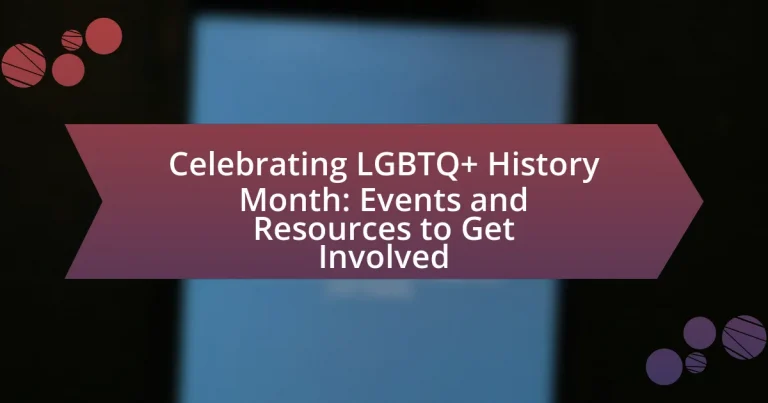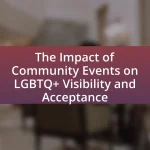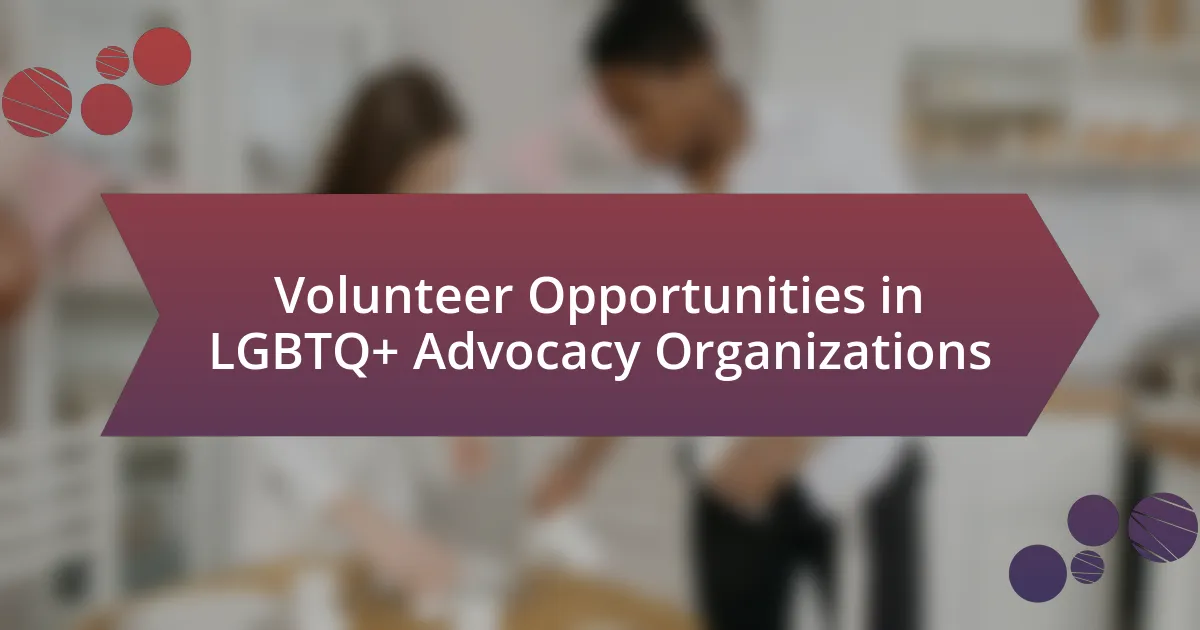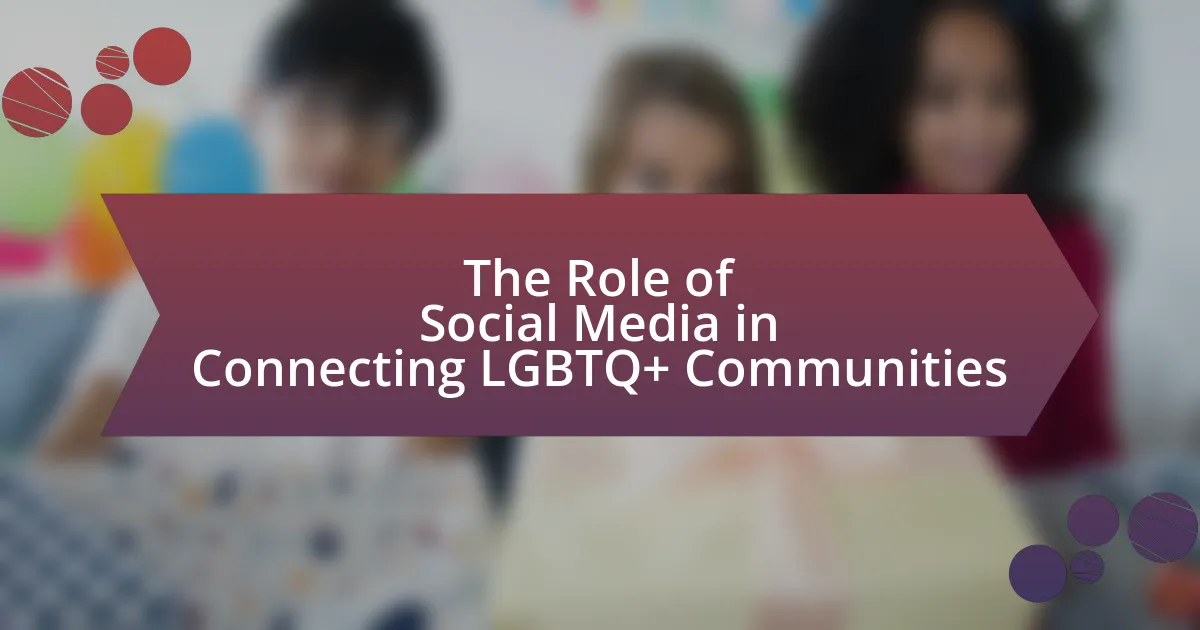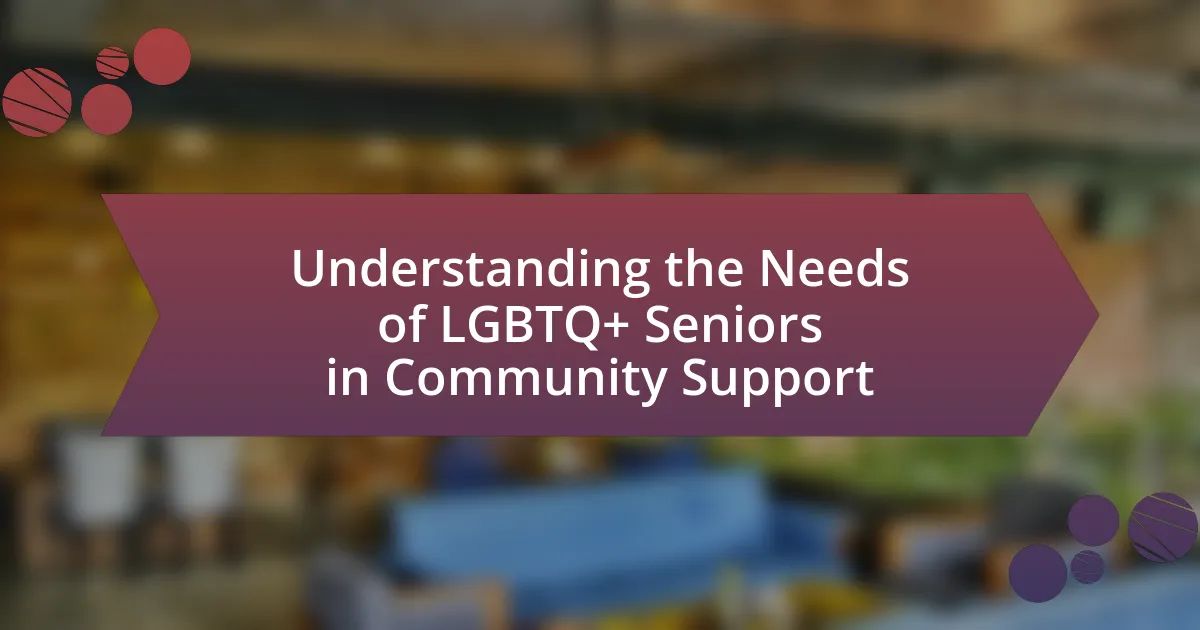LGBTQ+ History Month is an annual observance established in the United States in 1994, celebrated in October to honor the history, achievements, and contributions of the LGBTQ+ community. This month coincides with National Coming Out Day on October 11 and aims to educate the public about LGBTQ+ history while promoting awareness of ongoing struggles faced by LGBTQ+ individuals. The article outlines the significance of LGBTQ+ History Month, key historical events leading to its establishment, various educational and community events held during this time, and resources available for individuals and organizations to engage in meaningful celebrations and discussions. It also highlights the role of educational institutions and community organizations in fostering inclusivity and understanding within society.

What is LGBTQ+ History Month?
LGBTQ+ History Month is an annual observance dedicated to celebrating the history, achievements, and contributions of the LGBTQ+ community. Established in the United States in 1994, it takes place in October to coincide with National Coming Out Day on October 11. The month serves to educate the public about LGBTQ+ history and to promote awareness of the ongoing struggles faced by LGBTQ+ individuals. It is marked by various events, educational programs, and activities that highlight significant milestones and figures in LGBTQ+ history, such as the Stonewall Riots and the work of activists like Marsha P. Johnson and Harvey Milk.
Why is LGBTQ+ History Month celebrated?
LGBTQ+ History Month is celebrated to recognize and honor the contributions, history, and struggles of LGBTQ+ individuals and communities. This observance aims to promote awareness and understanding of LGBTQ+ issues, highlighting significant events and figures that have shaped the movement for equality. Established in the United States in 1994, LGBTQ+ History Month coincides with National Coming Out Day on October 11, reinforcing the importance of visibility and acceptance. The celebration serves as an educational opportunity, encouraging discussions about the ongoing fight for rights and representation, thereby fostering inclusivity and respect within society.
What historical events led to the establishment of LGBTQ+ History Month?
LGBTQ+ History Month was established in response to significant historical events that highlighted the struggles and achievements of the LGBTQ+ community. The first major event was the Stonewall Riots in 1969, which marked a pivotal moment in the fight for LGBTQ+ rights, leading to increased activism and visibility. In 1994, LGBTQ+ History Month was first celebrated in the United States, initiated by activist Rodney Wilson, who sought to promote awareness and education about LGBTQ+ history. This initiative was further supported by the establishment of National Coming Out Day in 1988, which encouraged individuals to embrace their identities and advocate for equality. These events collectively underscored the importance of recognizing LGBTQ+ history and contributed to the formal designation of October as LGBTQ+ History Month.
How does LGBTQ+ History Month promote awareness and education?
LGBTQ+ History Month promotes awareness and education by highlighting the contributions and struggles of LGBTQ+ individuals throughout history. This observance encourages educational institutions, organizations, and communities to engage in discussions, host events, and provide resources that inform the public about LGBTQ+ rights, history, and culture. For instance, schools often incorporate LGBTQ+ history into their curricula, which helps foster understanding and acceptance among students. Additionally, events such as lectures, film screenings, and art exhibitions serve to educate broader audiences about the significance of LGBTQ+ history, thereby increasing visibility and promoting inclusivity.
When is LGBTQ+ History Month observed?
LGBTQ+ History Month is observed in October. This month was chosen to coincide with significant events in LGBTQ+ history, including the anniversary of the 1975 founding of the first LGBTQ+ organization in the United States, the Gay Liberation Front, and the October 11 anniversary of National Coming Out Day.
What are the key dates and events during LGBTQ+ History Month?
LGBTQ+ History Month is celebrated in October, with key dates including National Coming Out Day on October 11, which encourages individuals to come out as LGBTQ+ and raise awareness about the community. Another significant event is Spirit Day on October 20, which promotes anti-bullying and supports LGBTQ+ youth. Additionally, LGBTQ+ History Month recognizes the contributions of LGBTQ+ individuals throughout history, with various educational events and activities organized by schools, organizations, and communities to honor this heritage. These events aim to foster understanding and acceptance while highlighting the ongoing struggles for LGBTQ+ rights.
How do different countries celebrate LGBTQ+ History Month?
Different countries celebrate LGBTQ+ History Month through various events and initiatives that highlight the contributions and struggles of LGBTQ+ individuals. In the United States, for example, LGBTQ+ History Month is observed in October with educational programs, film screenings, and community events that promote awareness and understanding of LGBTQ+ history. The UK also celebrates in February, featuring activities such as exhibitions, talks, and pride events that focus on LGBTQ+ history and rights. Canada recognizes LGBTQ+ History Month in October as well, with schools and organizations hosting discussions, workshops, and cultural events to educate the public. These celebrations often include the display of LGBTQ+ flags, the organization of parades, and the promotion of LGBTQ+ literature and art, reinforcing the importance of visibility and representation in society.

What events are held during LGBTQ+ History Month?
LGBTQ+ History Month features various events such as educational workshops, film screenings, panel discussions, and pride parades. These events aim to celebrate LGBTQ+ history, raise awareness about ongoing issues, and promote inclusivity. For instance, many organizations host workshops that focus on the contributions of LGBTQ+ individuals throughout history, while film screenings often showcase documentaries and films that highlight LGBTQ+ experiences. Additionally, panel discussions frequently include activists and historians who share insights on the significance of LGBTQ+ rights and history.
What types of events can individuals participate in?
Individuals can participate in various events during LGBTQ+ History Month, including parades, educational workshops, film screenings, art exhibitions, and community discussions. These events aim to celebrate LGBTQ+ history, promote awareness, and foster inclusivity. For example, many cities host pride parades that attract thousands of participants and spectators, showcasing the diversity and resilience of the LGBTQ+ community. Educational workshops often cover topics such as LGBTQ+ rights, history, and health, providing valuable information and resources. Film screenings may feature documentaries or narratives that highlight significant LGBTQ+ figures and events, while art exhibitions can showcase works by LGBTQ+ artists, further enriching the cultural landscape. Community discussions create safe spaces for dialogue and sharing experiences, enhancing understanding and solidarity within and beyond the LGBTQ+ community.
How can community organizations contribute to LGBTQ+ History Month events?
Community organizations can contribute to LGBTQ+ History Month events by organizing educational programs, workshops, and cultural activities that highlight LGBTQ+ history and achievements. These organizations can facilitate discussions, provide resources, and create safe spaces for individuals to share their experiences, thereby fostering community engagement and awareness. For instance, organizations like the Human Rights Campaign and GLAAD have historically hosted events that educate the public about LGBTQ+ rights and history, demonstrating the impact of community involvement in promoting understanding and acceptance.
What role do educational institutions play in celebrating LGBTQ+ History Month?
Educational institutions play a crucial role in celebrating LGBTQ+ History Month by providing educational programs, resources, and events that promote awareness and understanding of LGBTQ+ history and issues. These institutions often organize workshops, lectures, and discussions that highlight significant contributions of LGBTQ+ individuals and movements, fostering an inclusive environment. For example, many schools and universities incorporate LGBTQ+ history into their curricula, ensuring that students learn about the struggles and achievements of the LGBTQ+ community. This educational approach not only raises awareness but also encourages acceptance and support among students, contributing to a more inclusive society.
How can individuals get involved in local events?
Individuals can get involved in local events by participating in community organizations, volunteering for event planning, and attending gatherings related to LGBTQ+ History Month. Community organizations often host events and seek volunteers to help with logistics, outreach, and promotion. For example, local LGBTQ+ centers frequently organize educational workshops, parades, and social events, providing opportunities for individuals to engage actively. Additionally, attending these events fosters community connection and support, enhancing awareness and celebration of LGBTQ+ history and culture.
What are some examples of local events to attend?
Examples of local events to attend during LGBTQ+ History Month include pride parades, film screenings of LGBTQ+ themed movies, panel discussions featuring LGBTQ+ activists, art exhibitions showcasing LGBTQ+ artists, and community workshops focused on LGBTQ+ history and rights. These events often take place in community centers, local theaters, and public parks, providing opportunities for education, celebration, and advocacy within the LGBTQ+ community.
How can one volunteer for LGBTQ+ History Month activities?
To volunteer for LGBTQ+ History Month activities, individuals can reach out to local LGBTQ+ organizations or community centers that host events during this month. Many organizations, such as the Human Rights Campaign and GLAAD, often seek volunteers for various activities, including educational programs, parades, and awareness campaigns. Engaging with these organizations typically involves filling out a volunteer application or attending an orientation session, which provides details on available opportunities and the specific needs for the month.

What resources are available for LGBTQ+ History Month?
Resources available for LGBTQ+ History Month include educational materials, online archives, and community events. Organizations such as the Human Rights Campaign and GLAAD provide lesson plans, historical timelines, and multimedia resources that highlight significant LGBTQ+ figures and events. Additionally, libraries and educational institutions often host workshops, lectures, and film screenings to promote awareness and understanding of LGBTQ+ history. These resources are designed to engage individuals and communities in meaningful discussions and celebrations of LGBTQ+ contributions to society.
What educational materials can be accessed for LGBTQ+ History Month?
Educational materials for LGBTQ+ History Month include lesson plans, documentaries, articles, and online resources that focus on significant events, figures, and movements within LGBTQ+ history. Organizations such as the Human Rights Campaign and GLAAD provide comprehensive educational toolkits that feature historical timelines, biographies, and discussion guides. Additionally, libraries and educational institutions often curate collections of books and films that highlight LGBTQ+ contributions to society, ensuring a well-rounded understanding of the subject. These resources are designed to educate individuals about the struggles and achievements of the LGBTQ+ community, fostering awareness and inclusivity.
Where can one find books and documentaries about LGBTQ+ history?
Books and documentaries about LGBTQ+ history can be found at public libraries, university libraries, and online platforms such as Amazon and Netflix. Public libraries often have dedicated sections for LGBTQ+ literature and history, while university libraries may offer specialized collections and archives. Online platforms provide a wide range of documentaries and films that explore LGBTQ+ historical events and figures, such as “The Death and Life of Marsha P. Johnson” on Netflix, which highlights the life of a prominent LGBTQ+ activist. Additionally, organizations like the LGBTQ+ History Project and the American Library Association provide curated lists of resources and recommendations for further exploration of LGBTQ+ history.
How can online platforms enhance understanding of LGBTQ+ history?
Online platforms can enhance understanding of LGBTQ+ history by providing accessible educational resources, interactive content, and community engagement opportunities. These platforms often host digital archives, documentaries, and articles that detail significant events and figures in LGBTQ+ history, such as the Stonewall Riots and the AIDS crisis. For instance, the Human Rights Campaign offers a comprehensive timeline of LGBTQ+ milestones, which helps users grasp the evolution of rights and societal attitudes. Additionally, social media campaigns can amplify voices and stories from the LGBTQ+ community, fostering a deeper connection and awareness among diverse audiences.
What organizations provide support during LGBTQ+ History Month?
Organizations that provide support during LGBTQ+ History Month include the Human Rights Campaign, GLAAD, and the Trevor Project. The Human Rights Campaign advocates for LGBTQ+ equality and offers resources for education and awareness during this month. GLAAD focuses on media representation and provides tools for promoting LGBTQ+ visibility. The Trevor Project offers crisis intervention and suicide prevention services specifically for LGBTQ+ youth, emphasizing the importance of mental health support during this time. These organizations actively engage in events and initiatives that celebrate LGBTQ+ history and promote awareness.
Which advocacy groups are actively involved in LGBTQ+ History Month?
Advocacy groups actively involved in LGBTQ+ History Month include the Human Rights Campaign, GLAAD, and the National LGBTQ Task Force. These organizations promote awareness and education about LGBTQ+ history, culture, and rights through various events and resources during the month. For instance, the Human Rights Campaign has been instrumental in organizing events that highlight significant milestones in LGBTQ+ history, while GLAAD focuses on media representation and visibility. The National LGBTQ Task Force works on policy advocacy and community engagement to further LGBTQ+ rights, making them key players in the observance of LGBTQ+ History Month.
How can individuals connect with local LGBTQ+ organizations?
Individuals can connect with local LGBTQ+ organizations by attending community events, participating in pride parades, and utilizing online resources such as social media platforms and dedicated websites. Many organizations host regular meetings, workshops, and social gatherings that are open to the public, providing opportunities for engagement. Additionally, platforms like Meetup and Facebook often list local LGBTQ+ events, making it easier for individuals to find and join these activities. According to a report by the Human Rights Campaign, community involvement significantly enhances support networks for LGBTQ+ individuals, fostering a sense of belonging and advocacy.
What are some best practices for celebrating LGBTQ+ History Month?
Best practices for celebrating LGBTQ+ History Month include organizing educational events, promoting LGBTQ+ literature, and highlighting significant historical figures and milestones. Educational events, such as workshops and lectures, can provide insights into LGBTQ+ history and culture, fostering understanding and awareness. Promoting LGBTQ+ literature, including biographies and historical accounts, encourages reading and discussion about the community’s contributions and struggles. Additionally, highlighting significant figures, such as Marsha P. Johnson and Harvey Milk, and their impact on LGBTQ+ rights can inspire activism and appreciation for the history. These practices not only honor the past but also engage communities in meaningful dialogue and reflection.
How can individuals create inclusive spaces during events?
Individuals can create inclusive spaces during events by actively promoting diversity and ensuring accessibility for all participants. This can be achieved by implementing measures such as using gender-neutral language in event materials, providing options for dietary restrictions, and ensuring physical accessibility for individuals with disabilities. Research indicates that inclusive practices enhance participation and satisfaction among diverse groups, as evidenced by a study from the Journal of Diversity in Higher Education, which found that events with inclusive policies saw a 30% increase in attendance from underrepresented communities.
What tips can help maximize participation in LGBTQ+ History Month activities?
To maximize participation in LGBTQ+ History Month activities, organizations should actively promote events through diverse channels, including social media, community newsletters, and local partnerships. Engaging with the community by collaborating with LGBTQ+ organizations can enhance visibility and encourage attendance. Additionally, offering a variety of events that cater to different interests—such as educational workshops, art exhibits, and social gatherings—can attract a broader audience. Research indicates that inclusive programming increases participation rates; for instance, a study by the Human Rights Campaign found that events with diverse formats saw a 30% higher turnout compared to traditional lectures.
